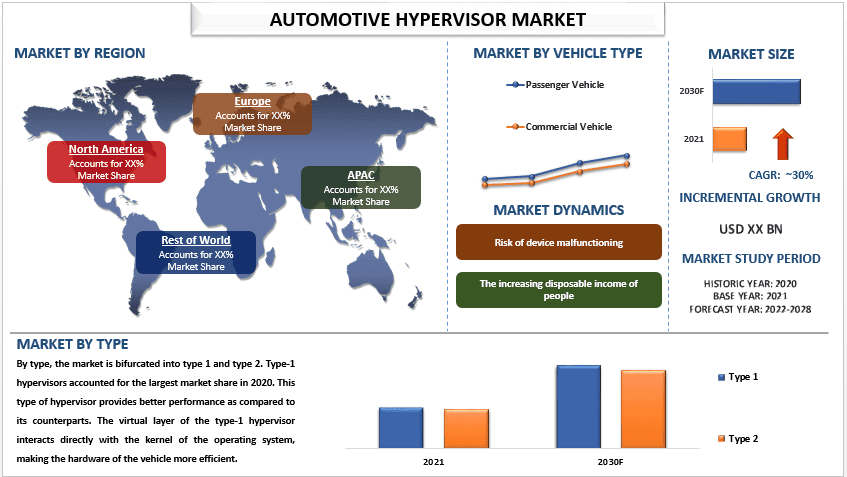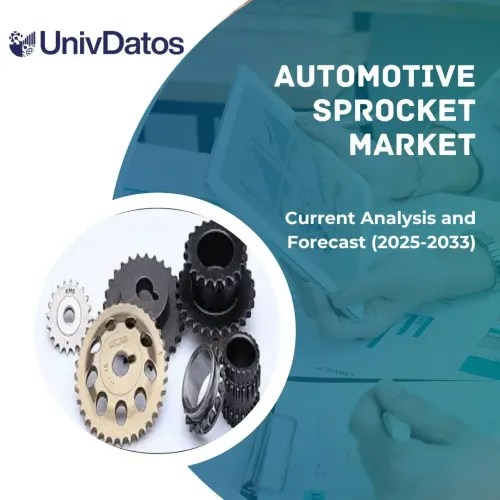- Home
- About Us
- Industry
- Services
- Reading
- Contact Us
Automotive Hypervisor Market: Current Analysis and Forecast (2022-2028)
Emphasis on Vehicle Type (Passenger Vehicle and Commercial Vehicle), Type (Type 1 and Type 2), Vehicle Class (Mid-Priced and Luxury), Automation (Semi-Autonomous and Fully Autonomous), and Region/Country.

The automotive hypervisor market is expected to grow at a strong CAGR of around 30% during the forecast period owing to the increasing awareness among customers, the proliferation of IoT in emerging economies, and surging disposable incomes and urbanization. Moreover, with increasing awareness about the need and benefits of automotive hypervisor technology, spending on product development and R&D activities has increased globally. Burgeoning competition in terms of new players foraying into the automotive hypervisor landscape along with evolving governmental energy and emission policies, growing demand for automotive hypervisor energy management systems, and development of smart gas metering services are some of the major drivers for the increased penetration of automotive hypervisor devices among consumers, especially in the developed and developing countries. Additionally, the rising investments and product launches in the automotive hypervisor market are further contributing to the growth of the market.
Some of the major players operating in the market include BlackBerry Limited.; Green Hills Software; IBM; NXP Semiconductors; Panasonic Holdings Corporation; Renesas Electronics Corporation; Sasken Technologies Ltd; Siemens; Visteon Corporation; and Wind River Systems, Inc. Several M&As along with partnerships have been undertaken by these players to facilitate customers with hi-tech and innovative products/technologies.
Insights Presented in the Report
“Amongst Automation, semi-autonomous held a significant share of the market in 2021”
Based on automation, the market is segmented into semi-autonomous and fully autonomous. Amongst these, semi-autonomous automation held a significant share of the automotive hypervisor market in 2021 because it represents a more incremental step toward fully autonomous driving, compared to fully autonomous automation. Semi-autonomous systems allow for some degree of automation, such as lane departure warning, adaptive cruise control, and automatic emergency braking, but still require a human driver to be present and ready to take control of the vehicle if necessary.
“Amongst Vehicle Type, the commercial vehicle to have significant growth during the forecast period.”
By technology, the market is bifurcated into passenger vehicles and commercial vehicles. Among these, commercial vehicles will have significant growth in the automotive hypervisor market during the forecast period. This is because commercial vehicles often have more advanced and complex systems compared to passenger vehicles, and therefore require more advanced hypervisors to manage these systems. Additionally, commercial vehicles are increasingly being equipped with advanced driver assistance systems (ADAS) and other safety features, which require advanced computing power and hypervisors to manage. This trend is expected to continue in the coming years, driving the growth of the automotive hypervisor market for commercial vehicles.
Automotive Hypervisor Market Report Coverage

“North America dominated the automotive hypervisor market in 2021.”
North America dominated the automotive hypervisor market in 2021 due to several factors. Firstly, North America has a large automotive industry, with major players such as Ford, General Motors, and Chrysler. These companies have been early adopters of hypervisor technology, using it to improve the safety and security of their vehicles. Secondly, the region has a strong ecosystem of technology companies that provide the hardware and software necessary for hypervisors. Finally, the region’s regulatory environment encourages the adoption of hypervisors, as they are seen as a way to improve the safety of vehicles. Recent developments by key market players in North America have further strengthened the region’s dominance in the automotive hypervisor market. In February 2021, BlackBerry Limited, a Canadian software company, announced a partnership with Amazon Web Services to develop and market a secure and scalable intelligent vehicle data platform, using hypervisor technology. This platform will enable automakers to securely access data from sensors and other sources in their vehicles, providing them with insights into vehicle performance and customer behaviors. In conclusion, North America’s dominance in the automotive hypervisor market is driven by its strong automotive industry, technology ecosystem, and regulatory environment.
Reasons to buy this report:
- The study includes market sizing and forecasting analysis validated by authenticated key industry experts.
- The report presents a quick review of overall industry performance at one glance.
- The report covers an in-depth analysis of prominent industry peers with a primary focus on key business financials, product portfolios, expansion strategies, and recent developments.
- Detailed examination of drivers, restraints, key trends, and opportunities prevailing in the industry.
- The study comprehensively covers the market across different segments.
- Deep dive regional level analysis of the industry.
Customization Options:
The global automotive hypervisor market can further be customized as per the requirement or any other market segment. Besides this, UMI understands that you may have your own business needs, hence feel free to connect with us to get a report that completely suits your requirements.
Table of Content
Research Methodology for the Market Analysis (2022-2028)
Analyzing the historical market, estimating the current market, and forecasting the future market of the global automotive hypervisor market were the three major steps undertaken to create and analyze the adoption of the automotive hypervisor in major regions globally. Exhaustive secondary research was conducted to collect the historical market numbers and estimate the current market size. Secondly, to validate these insights, numerous findings and assumptions were taken into consideration. Moreover, exhaustive primary interviews were also conducted, with industry experts across the value chain of the global automotive hypervisor market. Post assumption and validation of market numbers through primary interviews, we employed a top-down/bottom-up approach to forecasting the complete market size. Thereafter, market breakdown and data triangulation methods were adopted to estimate and analyze the market size of segments and sub-segments of the industry pertains to. Detailed methodology is explained below:
Analysis of Historical Market Size
Step 1: In-Depth Study of Secondary Sources:
Detail secondary study was conducted to obtain the historical market size of the automotive hypervisor market through company internal sources such as annual reports & financial statements, performance presentations, press releases, etc., and external sources including journals, news & articles, government publications, competitor publications, sector reports, third-party database, and other credible publications.
Step 2: Market Segmentation:
After obtaining the historical market size of the automotive hypervisor market, we conducted a detailed secondary analysis to gather historical market insights and share for different segments & sub-segments for major regions. Major segments are included in the report as vehicle type, type, vehicle class, and automation. Further country-level analyses were conducted to evaluate the overall adoption of testing models in that region.
Step 3: Factor Analysis:
After acquiring the historical market size of different segments and sub-segments, we conducted a detailed factor analysis to estimate the current market size of the automotive hypervisor market. Further, we conducted factor analysis using dependent and independent variables such as vehicle type, type, vehicle class, and automation of the automotive hypervisor market. A thorough analysis was conducted for demand and supply-side scenarios considering top partnerships, mergers and acquisitions, business expansion, and product launches in the automotive hypervisor market sector across the globe.
Current Market Size Estimate & Forecast
Current Market Sizing: Based on actionable insights from the above 3 steps, we arrived at the current market size, key players in the global market, and market shares of the segments. All the required percentage shares split, and market breakdowns were determined using the above-mentioned secondary approach and were verified through primary interviews.
Estimation & Forecasting: For market estimation and forecast, weights were assigned to different factors including drivers & trends, restraints, and opportunities available for the stakeholders. After analyzing these factors, relevant forecasting techniques i.e., the top-down/bottom-up approach were applied to arrive at the market forecast for 2028 for different segments and sub-segments across the major markets globally. The research methodology adopted to estimate the market size encompasses:
- The industry’s market size, in terms of revenue (USD) and the adoption rate of the automotive hypervisor market across the major markets domestically
- All percentage shares, splits, and breakdowns of market segments and sub-segments
- Key players in the global automotive hypervisor market in terms of products offered. Also, the growth strategies adopted by these players to compete in the fast-growing market
Market Size and Share Validation
Primary Research: In-depth interviews were conducted with the Key Opinion Leaders (KOLs) including Top Level Executives (CXO/VPs, Sales Head, Marketing Head, Operational Head, Regional Head, Country Head, etc.) across major regions. Primary research findings were then summarized, and statistical analysis was performed to prove the stated hypothesis. Inputs from primary research were consolidated with secondary findings, hence turning information into actionable insights.
Split of Primary Participants in Different Regions

Market Engineering
The data triangulation technique was employed to complete the overall market estimation and to arrive at precise statistical numbers for each segment and sub-segment of the global automotive hypervisor market. data was split into several segments & sub-segments post studying various parameters and trends in the areas of vehicle type, type, vehicle class, and automation in the global automotive hypervisor market.
The main Objective of the Global Automotive Hypervisor Market Study
The current & future market trends of the global automotive hypervisor market were pinpointed in the study. Investors can gain strategic insights to base their discretion for investments on the qualitative and quantitative analysis performed in the study. Current and future market trends determined the overall attractiveness of the market at a regional level, providing a platform for the industrial participant to exploit the untapped market to benefit from a first-mover advantage. Other quantitative goals of the studies include:
- Analyze the current and forecast market size of the automotive hypervisor market in terms of value (USD). Also, analyze the current and forecast market size of different segments and sub-segments.
- Segments in the study include areas of vehicle type, type, vehicle class, and automation.
- Define and analysis of the regulatory framework for the automotive hypervisor
- Analyze the value chain involved with the presence of various intermediaries, along with analyzing customer and competitor behaviors of the industry.
- Analyze the current and forecast market size of the automotive hypervisor market for the major region.
- Major countries of regions studied in the report include Asia Pacific, Europe, North America, and the Rest of the World
- Company profiles of the automotive hypervisor market and the growth strategies adopted by the market players to sustain in the fast-growing market.
- Deep dive regional level analysis of the industry
Related Reports
Customers who bought this item also bought










